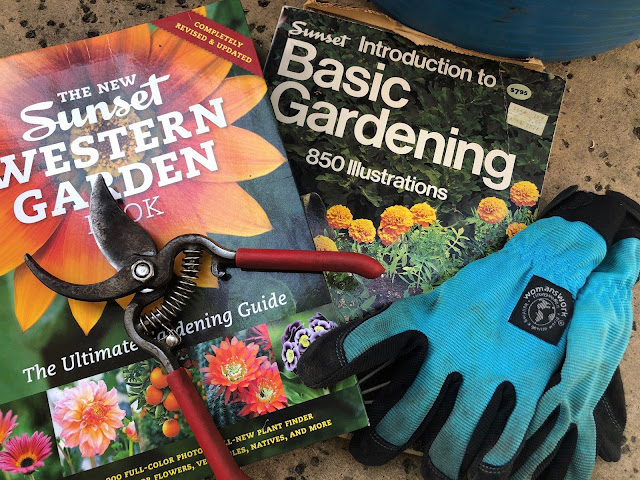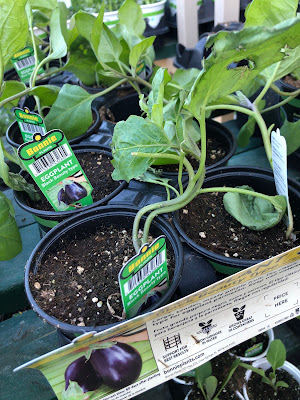
|
That's my original gardening book on the right, and the most recent edition of the "Sunset Western Garden Book" on the left. (Photos: Kathy Morrison)
|
A letter to a new gardener (from a slightly-less-new one)
Congratulations on joining the gardening community! You're in a great area to be a gardener. The Sacramento region can grow just about anything, and we can do it most of the year. Whether you have a yard, a patio or some pots on a balcony, you can enjoy the thrill of watching plants grow and enhancing the environment.
I was where you were 30 years ago this month, when my husband and I bought our first house. I knew next to nothing about gardening, even though my mom was an avid gardener. My first garden was a fixer-upper with the neglected remnants of someone's 1950s landscaping and several ancient fruit trees.
I made a lot of mistakes. You will, too. But that's how you learn.
A columnist years ago wrote a line that stuck with me: "The worst thing you can do is kill a plant, and you've already done that, haven't you?"
Nowadays, I can think of worse things to do in the garden than kill a plant, but you get the idea. If I may, I'm going to offer some advice so at least you won't make big expensive mistakes and get so frustrated that you quit before you even get going.
1. Learn the microclimates of your microclimate. This is your personal space, after all, and you'll soon know best what works where. Be out in the garden at different times of day. Observe where the shadows fall. What trees are around you? Do you have weeds in some areas but not in others? Weeds are garden opportunists, so that's a big clue. Don't be too ready to pull plants out or chop them down (OK, other than the weeds) -- they might turn into something you love. And look where your water sources are, too: One faucet each in front and back? Are there sprinklers or drip irrigation installed already? That will make a big difference in maintenance.
2. Investigate your soil. That's really, really important, before you add a single plant to the landscape: Stick a trowel or even an old kitchen knife in the ground in several spots. It may hit rock or roots or go in easily, or come out covered with sticky clay. Now you at least know what you're working with, and can amend as needed. Plants need good drainage to thrive, but the soil needs to be able to hold water, too. Dump a gallon of plain water into the area where you dug and watch how quickly it seeps in. A puddle means poor drainage. (See a great resource on soil
here
.)
3. Garden on the cheap for now. That doesn't mean using that only that kitchen knife and some Solo cups. Invest in one or two really good tools -- say, pruning shears and an excellent trowel -- but don't spend a fortune on garden "stuff" right off the bat. Gloves are a must for handling amendments and fertilizers, but they don't have to be leather. An old red wagon works for hauling plants; a standard 5-gallon bucket makes an excellent tool caddy. Wear any kind of hat you like and don't forget the sunscreen.
4. Start small. It's tempting to want to plant the whole garden in one season, but it'll be better off if you focus on a few things and really learn them. Love roses? Super, they're actually tough plants and are forgiving of beginner mistakes. Want a vegetable garden? Good: Pick the sunniest spot in your yard, and choose a couple varieties plus some herbs. Cherry tomatoes and zucchini are great starters. For now, stay away from corn (a water hog that needs a ton of room to do well), and plant carrots only if you have sandy soil or a raised bed. And that brings me to ...

|
This poor eggplant, photographed on March 2, has little chance
of doing well and is best avoided.
|
5. Just because stores have plants for sale doesn't mean it's the right time to grow them. I used to feel sorry for out-of-season plants; now I feel sorry for the gardeners who buy them. The big box stores, especially, are trying to SELL plants, they don't raise them and don't care what happens to them after they're purchased. Look at the poor eggplant seedling in the photo taken this week. It probably was started in a greenhouse in December. Eggplant is a warm-weather vegetable that really shouldn't be planted until late April or early May when the soil temperature hits 60 degrees minimum. What's it going to look like by then? Soil temperature is much more important to a plant than the air temperature, since that's where the roots are. "Farmer Fred" Hoffman has a
great chart on his blog
that can guide you on soil temps for the Sacramento Valley. And that leads me to ...
6. Soak up all the info you can. There are a lot of books out there, but they're usually not written with our climate in mind, "The Sunset Western Garden Book" being the big exception. Free classes and workshops are offered all over the region, especially this time of year. The UCCE master gardeners are an invaluable free resource, and you can call or email their help desk if you have questions about anything, from seed starting to pest identification.
Sacramento County
is 916-876-5338, mgsacramento@ucanr.edu;
Placer
,
El Dorado
and
Yolo
counties each have their own. Also, walk around your neighborhood and look at the varieties of plants doing well. Go on garden tours -- many are coming in April and May. Visit garden clubs and plant sales. Gardeners LOVE to talk about gardening, so ask questions (but keep advice No. 1 in mind).
7. Enjoy it! Gardening is good exercise and a wonderful stress reliever, and it will keep you mentally active. When you realize you'll never know everything about gardening, it actually becomes less frustrating, not more so. I like to quote third U.S. President Thomas Jefferson, who loved growing things and was always trying new plants: "
Tho' an old man, I am but a young gardener."
After 30 years, I still feel like a young gardener, too.
All the best,
Kathy


